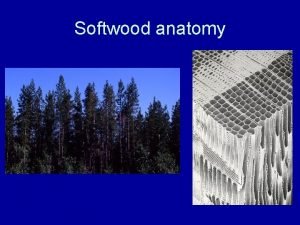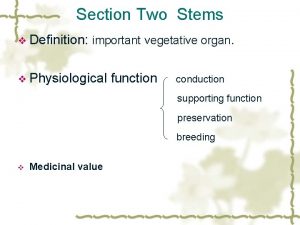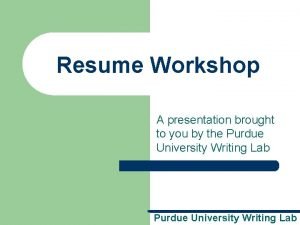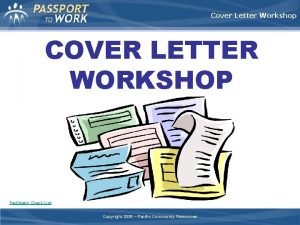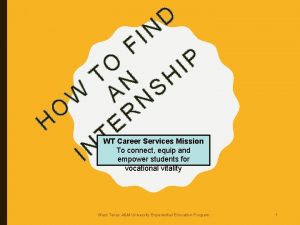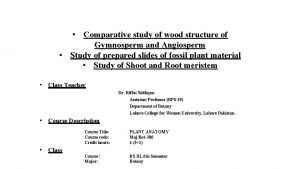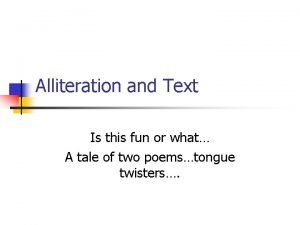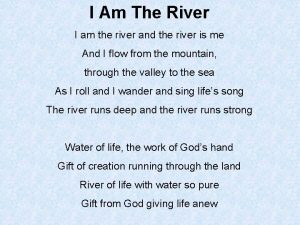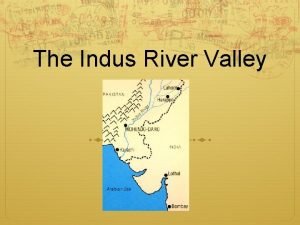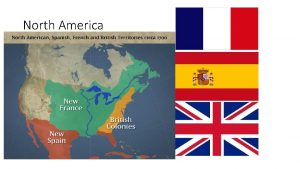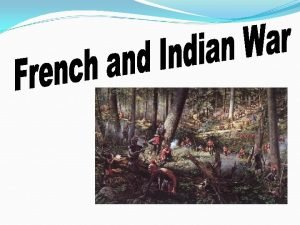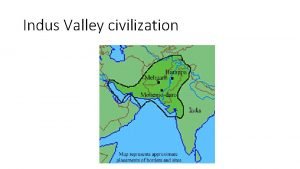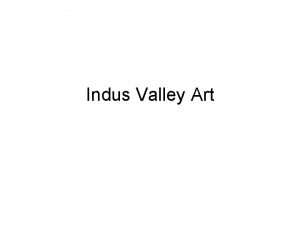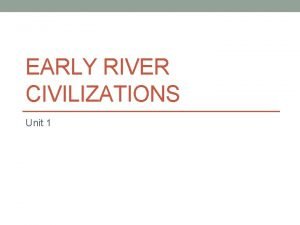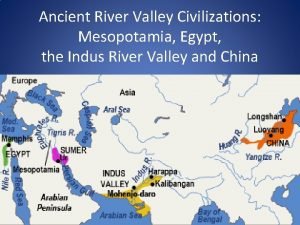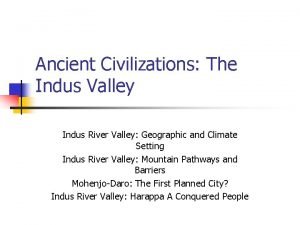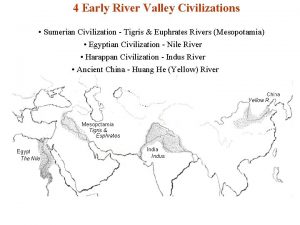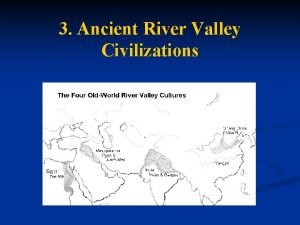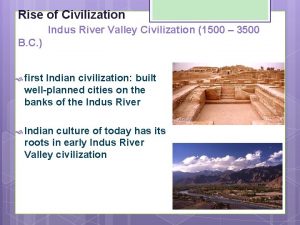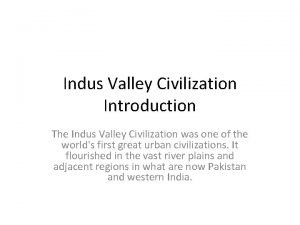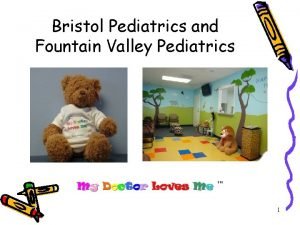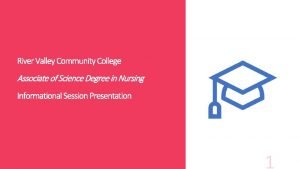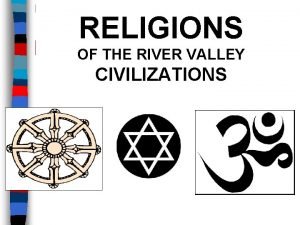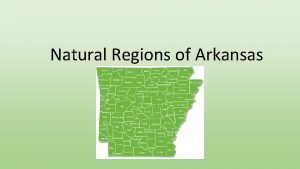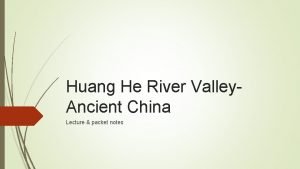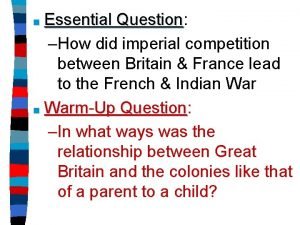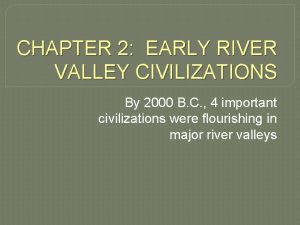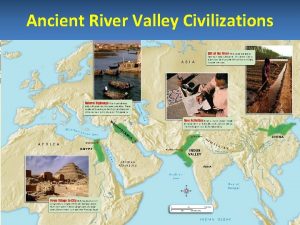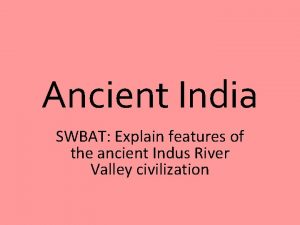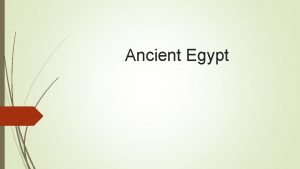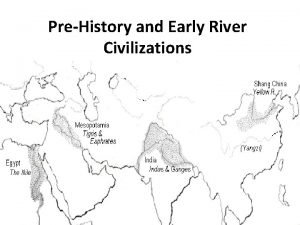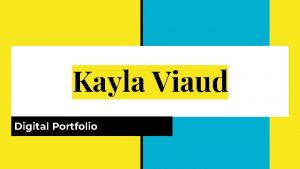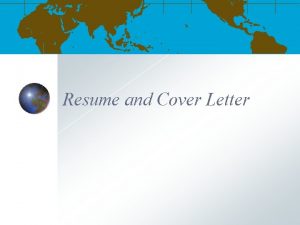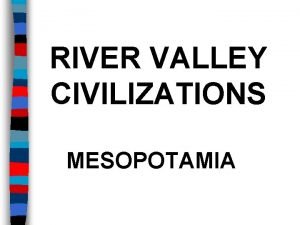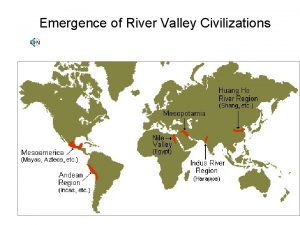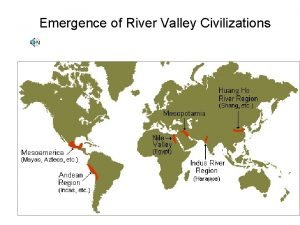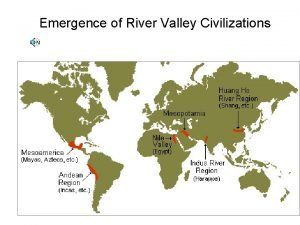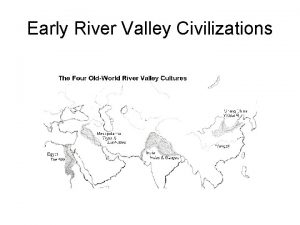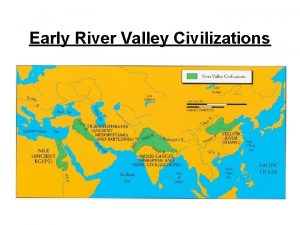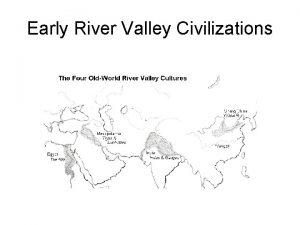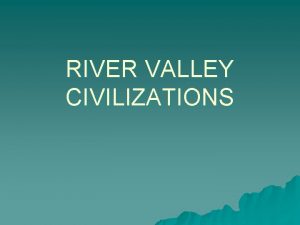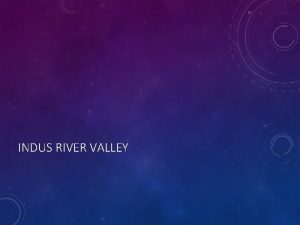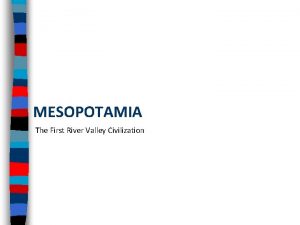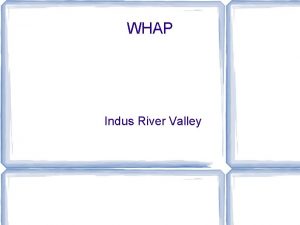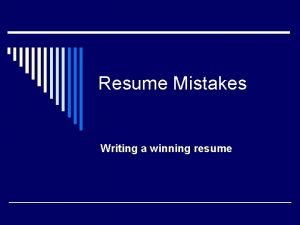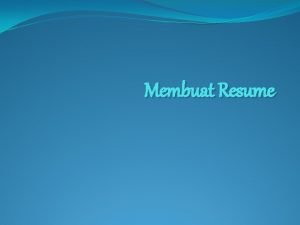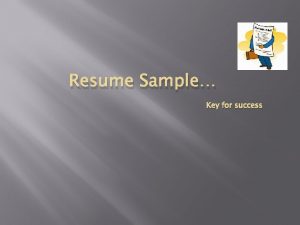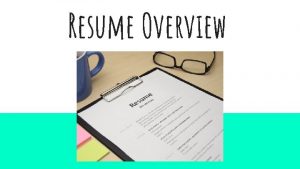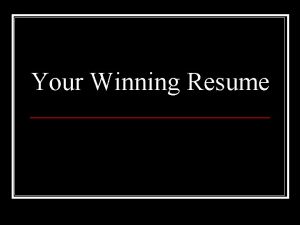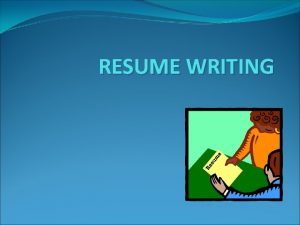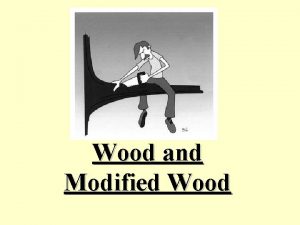Artist Statement and Resume Workshop Wood River Valley


































- Slides: 34

Artist Statement and Resume Workshop Wood River Valley Studio Tour in collaboration with Sun Valley Center for the Arts

Resume Writing The following suggestions come from (and can be found on) the College Art Association website: http: //www. collegeart. org/guidelines/resume

Basic Formatting Suggestions • List your most recent entries first, under each heading. • Use 10– 12 -point type in a standard, legible typeface, such as Times New Roman, Bodoni, Baskerville, Caslon, Garamond, and Palatino. • Avoid using exotic typefaces. • San serif typefaces such as Helvetica or Arial are usually more difficult to read.

Resume Content Depending on your strengths as an artist, you may rearrange the recommended order of some of the categories found below. As a general rule, you should “play to your strengths” by placing more important, relevant, and recent information near the beginning of your résumé. For obvious reasons, do not list category headings that are not relevant to you.

1. Name (and Contact Information) • Name: Your name can appear in uppercase, bold, or large type. • Preferred mailing address: Providing a mailing address is optional. Some artists may prefer not to include this, for security reasons. • Phone Number(s): List any numbers (work, studio, cell, home) where you are comfortable being contacted. Some artists may choose to remove their cell number and other personal address information from their résumé—especially from a website résumé. • Email: An email address (a must!) on the artist résumé is typically a personal, non-institutional email address. When you use a personal email address, use one that looks professional. • Personal Website: Personal websites are becoming more and more essential. Providing a URL to a personal website is highly recommended.

2. Education • List dates (year only, on left) of academic degrees in reverse chronological order, noting honors or distinctions. • If currently enrolled, indicate expected graduation date. • If no degree was obtained, indicate period of study after list of degrees earned.

Sample 2013 MFA (candidate) in Sculpture, California Institute of the Arts, Valencia, CA (expected graduation: May 2013) 2010 BFA in Studio Art, University of Oklahoma, Norman, OK 2005 BA cum laude, French, Southern Methodist University, Dallas, TX 2006 Memphis College of Art, Memphis, TN 2004 Pont-Aven School of Art, Pont-Aven, France (summer session)

3. Grants/Awards (Grants, fellowships, awards, honors, residencies, etc. ) List in reverse chronological order, with date on left: 1998 New York State Council on the Arts Fellowship, New York, NY 1991 Artist-in-Residency Fellowship, Roswell Museum and Art Center, Roswell, NM *Residencies can also be listed as a separate category.

4. Exhibition Record This is the most important section of the resume, and can be listed before Grants/Awards If you have many exhibitions, break them into categories: solo exhibitions and group exhibitions List in reverse chronological order, noting: • Year • Title of exhibition (in italics) • Name of venue • City, State • If applicable, also list juror or curator

Sample Solo Exhibitions: 2012 Rapid Oxidation, Enso Artspace, Boise, ID 2010 Burn Pile, The Friesen Gallery, Northwest Nazarene University, Nampa, ID 2008 No Nature, Only Things, J Crist Gallery, Boise, ID Group Exhibitions: 2014 Forests, Foraging and Fire, Sun Valley Center for the Arts, Ketchum, ID 2013 Idaho Triennial, Boise Museum of Art, Boise, ID (curated by Bonnie Laing-Malcolmsen, Portland Art Museum)

5. Commissions (if applicable, and especially for public art) List in reverse chronological order, noting type of project, title, medium, location, commissioning entity: 1995 Public Art Commission, Diversity and Hope, 8 x 16 ft. painting, acrylic and oil on canvas and panel, Charlotte Convention Center, Charlotte-Mecklenburg Arts & Science Council, Charlotte, NC

6. Collections (Public, Corporate, Private) • List alphabetically, under subcategories if needed. • Always obtain permission of private collectors before listing them. • Do not list friends/family members. Sample: Hirshhorn Museum and Sculpture Garden, Washington, DC Norton Family Collection, San Jose, CA Paterson Museum, Paterson, NJ Progressive Art Collection, Cleveland, OH West Collection, Paoli, PA

7. Bibliography List places your work has appeared published: books, magazines, newspapers, websites, TV or radio List in reverse chronological order following a specific bibliographical style (Chicago Manual of Style, MLA, etc. ) – choose one and be consistent.

Samples Eve Diaz, “Critic’s Picks, ” Artforum, February 28, 2010. http: //artforum. com/archive/id=25015 Willard W. Wilson, “Sculpture Exhibition, ” Syracuse Gazette, Syracuse, NY, December 11, 1998. 42. Diane Terrel, “New Work in Central New York, ” Sculpture 17, no. 1 (January 1998): 63. Jane Williams, Interview, WUWJ Radio, Utica, NY, December 9, 1997.

8. Publications as Author • List in reverse chronological order, following same format as above • Omit author (your) name

9. Teaching or Related Experience Teaching Experience 2009 -10 Visiting Assistant Professor, Boise State University, Boise, ID Related Experience 2010 -12 Curator, Sun Valley Center for the Arts, Ketchum, ID

10. Lectures/Workshops (Presentations, Artist Talks, etc. ) List in reverse chronological order Note type of event, title (if applicable), venue, location, dates 2012 Lecture/Presentation, School of the Art Institute of Chicago, IL, November 8 2012 Workshop, “Visual Artist Focus: Working with Galleries 101, ” Manhattan Arts Council, New York, NY, October 16 2011 Artist Talk, School of the Visual Arts, New York, NY, February 15 -18

11. Curatorial Projects If you have curatorial experience, list projects in reverse chronological order Include title (in italics), venue, city, state 2009 Make it Real, co-curated with Alison Gerber, No Name Exhibitions at The Soap Factory, Minneapolis, MN 2006 Idaho Triennial, Juror, Boise Art Museum, Boise, ID

12. Gallery Affiliation • Only list those galleries where you have current representation • Do not list galleries where you have exhibited unless they currently represent you Samples: Hodges Taylor Gallery, Charlotte, NC Arthur Rogers Gallery, New Orleans, LA

Artist’s Statement Why do I need one? I make pictures not words. Shouldn’t the work stand for itself? • Using written language to express what you do visually. 1. Statement is a way in to the work 2. Offers guidance and an introduction • Artists need to be able to be articulate about their work—the exercise of writing a statement can help strengthen and guide your practice and clarify your ideas

How Can Artist Statements Help Viewers (and Artists)? A Case Study Troy Simmons

Opposites attract. Although rather cliché, it’s a theme that echoes true to my intense fascination with nature and modern Brutalist Architecture. Concrete, acrylic and raw natural elements allow me to physically explore the ideological perceptions of incompatible binary relationships. (…) As I create, I envision images of vegetation growing from a single crevice in a concrete sidewalk, post apocalyptic cities with skyscrapers and buildings overtaken by fields of dandelions and tulips. My art is created to show the beauty of persistence and coexistence. Whether in our relationships or careers, it’s a struggle we all encounter in our daily lives. -Troy Simmons

Artist’s Statement What should it include? • Insight into intention, process, influences Why you make your art? What do you make? What inspires/influences you to make your art? Why have you chosen the medium/material you use? I want to make art that…. • Do not tell people what to feel or see but where it comes from—make it personal not theoretical

Make it personal I use my own constructed image as a vehicle for questioning ideas about the role of tradition, the nature of family, monogamy, polygamy, relationships between men and women, between women and their children, and between women and other women– underscoring the critical problems and the possible resolves. In one way or another, my work endlessly explodes the limits of tradition. Carrie Mae Weems

Artist’s Statement HOW? • Sit down, and write • Use simple adult language that is welcoming (no jargon) • 2 -3 paragraphs of 3 to 4 sentences each • Clarity is best. Brevity is good. • Put it away. Show it to someone you trust and who reads or writes. • Rewrite.

Three Questions to Ask Before Writing • Who are you really writing for? – Tailor your statement to different audiences: jurors, exhibition visitors, grant reviewers all have different needs and expectations of your statement. • Which words to you use? – It’s okay to use words that are less common, but avoid jargon. Make sure the words you use really mean something in relationship to your art. • How do you structure your sentences? – Keep them short, active, and to the point.

Editing is key! Knitting is my key to the secret garden, my way down the rabbit hole, my looking glass. Hand knitting started it. From the beginning the process of transforming string into cloth has struck me as magical. And over the years, that magical process had its way with me, leading me from hobby to art. Knitting fills me with a sense of accomplishment and integrity, and has proven a most amenable vehicle for translating inner vision to outer reality. I knit from the inside out. Though I work quite deliberately, consciously employing both traditional and innovative techniques, my unconscious is the undisputed project manager. The concrete repetitive nature of this work frees my imagination and provides many opportunities for happy accident and grace to influence the finished product. Recently, I discovered some childhood drawings: simple, crayoned patchworks that resonate deeply with my fiber work. Inspired and invigorated by a renewed sense of continuity, and awed by the mystery of how creation occurs, I am now knitting richly varied fabrics exploring many patterns, textures and colors. Once knit, the fabrics are pieced to form an always new patchwork from which I make my garments and accessories. Molly Gordon

Editing is key! Knitting is my key to the secret garden, my way down the rabbit hole, my looking glass. Hand knitting started it. From the beginning the process of transforming string into cloth has struck me as magical. I knit from the inside out. Though I work quite deliberately, consciously employing both traditional and innovative techniques, my unconscious is the undisputed project manager. Recently, I discovered some childhood drawings: simple, crayoned patchworks that resonate deeply with my fiber work. Inspired and invigorated by a renewed sense of continuity, and awed by the mystery of how creation occurs, I am now knitting richly varied fabrics exploring many patterns, textures and colors. Once knit, the fabrics are pieced to form an always new patchwork from which I make my garments and accessories. Molly Gordon

Include process…. but not too much Bean Finneran works with one simple elemental form, a hand rolled curve of clay, repeated and grouped into primary geometric constructions. The clay is a connection to time, to the earth and to human culture. The curve is a meditation on multiplicity in nature like individual blades of grass in a field. Following rhythms of renewal and transformation in nature the composition of the sculptures is transitory. Each one of a thousand individual curves is physically independent from the next so that when a sculpture is moved it must be disassembed and then reconstructed curve-by-curve. The curves are reinterpreted every time a sculpture is assembled; ever similar and always unique. The process of creating the sculptures has no beginning or end

Address intention without telling My work invites confusion on several levels, and that ‘meaning’ is generated in the process of sorting things out. On the most obvious level, we all expect photographs to be pictures of something. We assume that the photographer observed a place, a person, an event in the world and wanted to record it…. the problem with my work is that these images are really not of anything in that sense, they register only that which is incidental. Uta Barth

What inspires you to make your art? (Hans) Holbein brought an enormous amount of dignity to his work (along with rich color and saturation). There was an equality to his paintings—they weren’t demigod portraits, they were just incredibly detailed and real. When I saw that, I realized that I wanted to mirror his work with members of my own community. It seemed like a good conversation to have, especially in relationship to the s/m community, which was thought of—and still is thought of, to an extent—as predatory or perverted. Catherine Opie

My paintings are part of a visual dialogue running the length and breadth of human history. The search for excellence in this Art and Craft has led me to explore the natural world and the human events that inhabit it, constructing narratives that celebrate and question our presence in the world. Although representational, I seek a way of painting that is richly traditional, yet radically and surprisingly new. I attempt to articulate more than the surfaces and dimensions of reality, summoning the wordless meanings and sensations that only visual art can. Chester Arnold

Write with Your Reader in Mind I explore science through art. By layering acrylic paint, pumice, plaster, and various mediums, I seek to emulate earth patterns, where form and function are intertwined. My mixtures on canvas create organic images that speak of weathering, dripping water, tangled reeds--providing a continuous reminder of the complexity and wonder of (These two the natural world. … paragraphs were Making art allows me to reach deep within. Increasingly embracing the physical act and process of painting-rather than focusing on predetermined outcomes--helps me move beyond the analytical to tap into a place of inexplicable energy, life force, and emotion. When I am able to access this well, art works flow forth in mystical pulses. On occasion, the strength of this energy surprises me. This is when painting = bliss. Wendy Pabich originally flipped. )

Resources: Artist’s Statements • http: //www. artbusiness. com/artstate. html • http: //www. cgu. edu/pages/7483. asp • http: //www. artstudy. org/art-and-designcareers/sample-artist-statement. php • http: //www. lightspacetime. com/newsletter/how -to-write-the-perfect-artist-statement/
 Softwood anatomy
Softwood anatomy Early wood and late wood difference
Early wood and late wood difference Resume workshop presentation
Resume workshop presentation Request letter for training facilitator
Request letter for training facilitator Wtamu resume workshop
Wtamu resume workshop East river valley religion
East river valley religion Gymnosperm structure
Gymnosperm structure Wood sawed wood old tongue twister
Wood sawed wood old tongue twister Wood wood teenager
Wood wood teenager I am the river and the river is me
I am the river and the river is me Ganges river valley
Ganges river valley The albany plan of union
The albany plan of union Ohio river valley 1763
Ohio river valley 1763 River valley civilizations map
River valley civilizations map Modern day indus valley
Modern day indus valley Proto siva
Proto siva 4 river valley civilizations
4 river valley civilizations 4 river valley civilizations
4 river valley civilizations Harappa
Harappa River valley civilizations map
River valley civilizations map What is believed to be the 1 stdynasty of ancient china?
What is believed to be the 1 stdynasty of ancient china? Seasonal winds that dominate india's climate
Seasonal winds that dominate india's climate Indus era
Indus era Central valley pediatrics
Central valley pediatrics River valley community college
River valley community college River valley civilizations religion
River valley civilizations religion Arkansas 6 regions
Arkansas 6 regions Ancient china packet
Ancient china packet Ohio valley river
Ohio valley river Chapter 2 early river valley civilizations
Chapter 2 early river valley civilizations Ancient river valley civilizations powerpoint
Ancient river valley civilizations powerpoint Indus river valley dbq
Indus river valley dbq Ancient egypt advanced cities
Ancient egypt advanced cities River valley civilizations map
River valley civilizations map River valley civilizations vocabulary
River valley civilizations vocabulary
